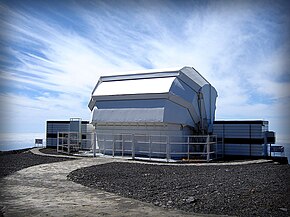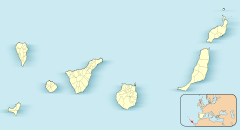 | |
| Part of | Roque de los Muchachos Observatory |
|---|---|
| Location(s) | Garafía, Province of Santa Cruz de Tenerife, Canary Islands, Spain |
| Coordinates | 28°45′44″N 17°52′45″W / 28.76234°N 17.87925°W / 28.76234; -17.87925 |
| Organization | Liverpool John Moores University |
| Observatory code | J13 |
| Altitude | 2,363 m (7,753 ft) |
| Telescope style | Ritchey–Chrétien telescope robotic telescope |
| Diameter | 2 m (6 ft 7 in) |
| Website | telescope |
 | |
| | |
| [edit on Wikidata] | |
The Liverpool Telescope (LT) is a two-metre-aperture robotic Ritchey–Chrétien telescope that observes autonomously (without human intervention). However professional astronomers, school groups and other credible registered users submit specifications to be considered by its robotic control system (RCS) at any time using an online graphical user interface. Each night the RCS decides among these choices, and among any notified or glimpsed transient events, what to observe, based on target visibility and weather conditions.
The telescope had first light in 2003, and is the brainchild and property of Liverpool John Moores University.
Description

The RCS has a rapid-response capability where it will often automatically interrupt regular observations to slew (shift) to observe short-lived events with higher priority, such as gamma-ray bursts.
The LT is one of the largest robotic telescopes in the world and was built by a subsidiary set up by Liverpool John Moores University who own and masterminded it. It is operated (maintained) by the Astrophysics Research Institute, partly funded by the UK's STFC. It is at the Roque de los Muchachos Observatory on La Palma.
Along with the Faulkes Telescope North and South, it is available for use by school children around the world over the internet. The registration and time allocation for the LT is organised by the National Schools Observatory.
The Liverpool Telescope is one of the primary players in the Heterogeneous Telescope Networks Consortium, a global collaboration between major research groups in the field of robotic telescopes which seeks a standard for communication between remote telescopes, telescope users, and other scientific resources.
Plans for an improved version, the Liverpool Telescope 2, are underway.
See also
Notes and references
- Notes
- 6.6-foot in imperial terms
- Telescope Technologies Limited
- References
- "Liverpool Telescope – Robotic Systems". Archived from the original on 20 July 2014. Retrieved 6 March 2013.
- Leverington, David (2017). Observatories and Telescopes of Modern Times. Cambridge University Press. ISBN 9780521899932.
- "Robot telescope is world's largest". 4 August 2003. Retrieved 6 March 2013.
- "Liverpool Telescope – National Schools Observatory".
- Copperwheat, C. M.; Steele, I. A.; Barnsley, R. M. (1 March 2015). "Liverpool telescope 2: a new robotic facility for rapid transient follow-up". Experimental Astronomy. 39 (1): 119–165. arXiv:1410.1731. Bibcode:2015ExA....39..119C. doi:10.1007/s10686-015-9447-0. S2CID 54641125.
External links
- Liverpool Telescope website
- National Schools' Observatory – allocates observing time to schools
- RoboNet – controls telescopes over the internet
- Heterogeneous Telescope Networks Consortium
- "Liverpool Telescope". Deep Space Videos. Brady Haran.
| Liverpool John Moores University | |
|---|---|
| People | |
| Campuses |
|
| Schools and institutes | |
| Other | |